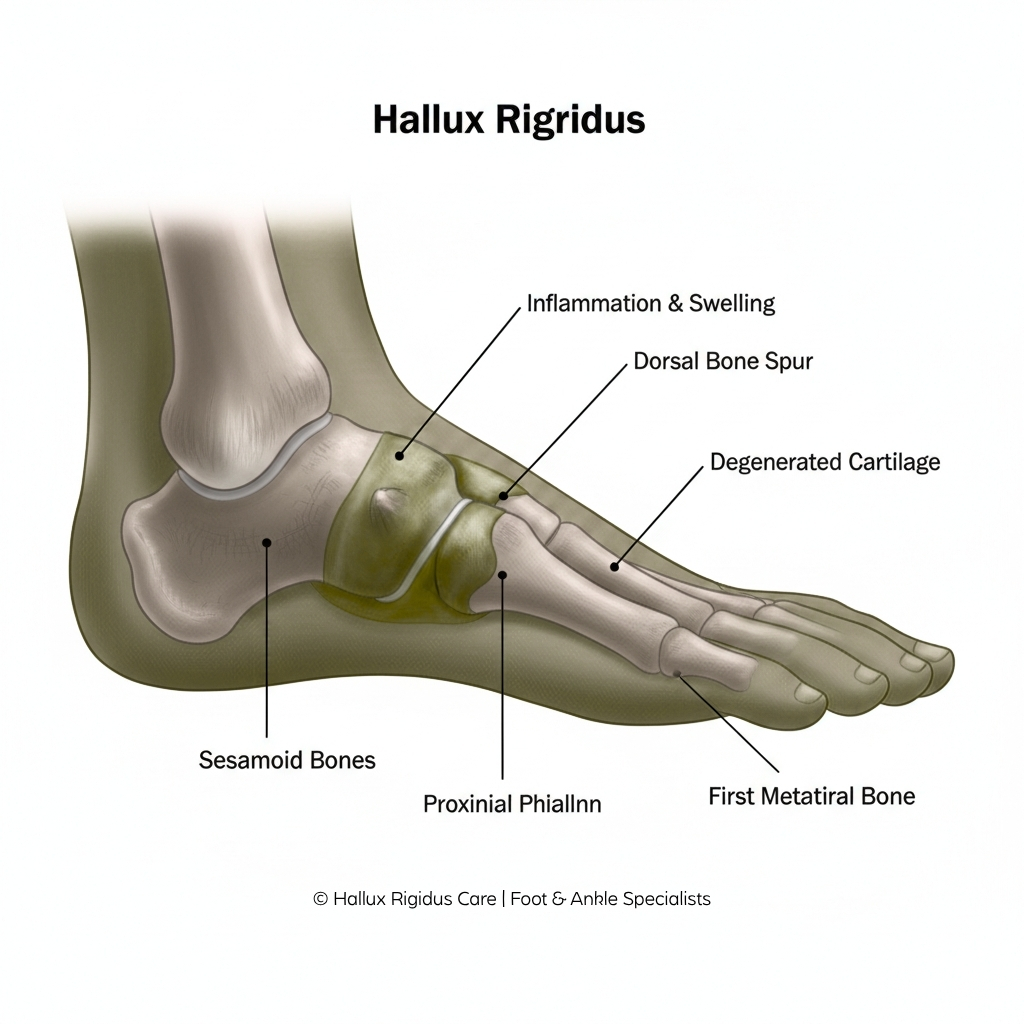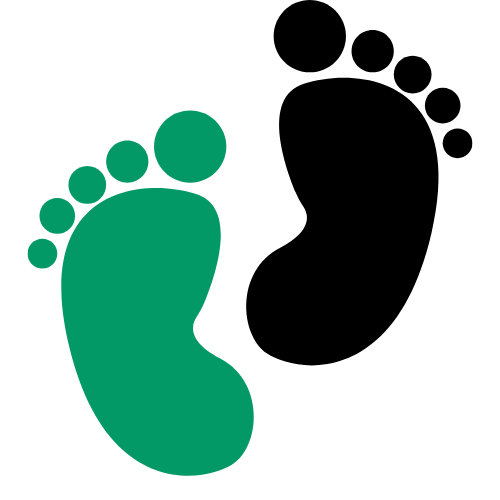Hallux Rigidus is a degenerative joint condition that affects the big toe and recognizing the early signs of Hallux Rigidus can make all the difference. Detecting this stiffness and discomfort early helps you take steps to prevent pain, preserve mobility, and avoid long-term joint damage.
Recognizing the early signs of Hallux Rigidus is essential for preventing long-term pain, joint damage, and reduced mobility. Early detection allows for timely intervention — giving you the chance to slow down the progression and maintain a pain-free stride.
Let’s explore what Hallux Rigidus really is, what causes it, and how to spot the earliest symptoms before it becomes a daily struggle.
_____________________________________________________________________________________________________________________________________
What Is Hallux Rigidus?
Hallux Rigidus is a form of degenerative arthritis that affects the joint at the base of your big toe — medically known as the first metatarsophalangeal (MTP) joint.
Over time, the cartilage that cushions this joint wears down, leading to stiffness, inflammation, and sharp pain whenever you move your toe.

Because this joint plays a major role in walking and balance, the condition can significantly impact mobility. Left untreated, it can progress from mild stiffness to complete joint immobility.
According to the Arthritis Foundation, early diagnosis and lifestyle adjustments can slow the joint’s degeneration and help patients maintain a healthy range of motion for longer.
How Early Signs of Hallux Rigidus Begin to Develop
Hallux Rigidus doesn’t appear overnight, it develops gradually.
Here are the most common reasons it occurs:
- Overuse of the big toe joint due to sports or repetitive movements like running or squatting
- Genetic factors or family history of arthritis
- Previous foot injuries, such as sprains or fractures, that damaged the joint
- Abnormal foot structure, including flat feet or an unusually long first metatarsal bone
These factors place excessive stress on the big toe joint, accelerating wear and tear that leads to stiffness and pain.
Who Is Most at Risk?
Anyone can develop Hallux Rigidus, but certain people are more vulnerable:
- Adults aged 30–60 who engage in high-impact activities
- Athletes, dancers, or runners who regularly stress the big toe joint
- Individuals with inflammatory diseases like gout or rheumatoid arthritis
- Those with a family history of osteoarthritis or joint deformities
Understanding your risk helps you stay proactive — because early awareness can prevent lifelong discomfort.
Detailed Early Signs and Symptoms That Indicate the Onset of Hallux Rigidus Early
Knowing what to look for can make all the difference.
Here are the most common early signs and symptoms of Hallux Rigidus:
1. Pain in the Big Toe Joint
Persistent or occasional pain in your big toe joint — especially during walking or running — is often the first warning sign.
Initially, the pain might come and go, but over time, it can persist even at rest. This pain results from inflammation and cartilage loss that expose underlying bone tissue.
If you notice a dull ache or throbbing discomfort after physical activity, don’t dismiss it. Early medical attention can help manage pain and prevent long-term stiffness.
2. Stiffness and Swelling
Stiffness, particularly after rest or in the morning, is one of the clearest indicators of Hallux Rigidus.
As the condition progresses, inflammation around the big toe joint can cause noticeable swelling and tenderness.
This stiffness makes it difficult to bend your toe or move it upwards — a symptom that worsens without early care.
3. Limited Range of Motion
A reduced ability to move the big toe — whether bending it upward (dorsiflexion) or downward (plantarflexion) — is a hallmark symptom.
People often notice this when standing on tiptoes or pushing off while walking. As motion decreases, the surrounding muscles and joints may compensate, leading to uneven walking patterns and fatigue in the foot.
Note: For those who stay active, especially runners, restricted motion can make workouts painful. Wearing the right footwear helps reduce joint stress. Check our guide on the best running shoes for Hallux Rigidus designed to support flexibility and comfort.
4. Bony Growths or Hard Lumps
Another visible sign is the development of bony bumps (osteophytes) near the affected joint.
These growths form as your body tries to stabilize the degenerating joint but end up causing more stiffness and discomfort.
They may rub against shoes, leading to irritation and calluses — making everyday footwear painful to wear.
5. Discomfort When Wearing Shoes
Hallux Rigidus can make wearing tight or narrow shoes unbearable.
If you find yourself constantly reaching for wider shoes, soft insoles, or toe spacers to ease the pain, it’s time to take the issue seriously. The discomfort is usually caused by swelling or bone spurs pressing against the shoe lining.
For relief, check our guide on 20 Best Walking Shoes for Hallux Rigidus — it covers both men’s and women’s options designed for joint comfort and flexibility.
6. Changes in Walking Pattern
When pain and stiffness take over, many people unconsciously change their gait to avoid pressure on the big toe.
This adjustment might reduce pain temporarily, but it shifts stress to other parts of your foot, knee, and hip — potentially creating new problems.
If your stride feels “off” or others notice a limp, consult a specialist before the imbalance causes long-term damage.

7. Swelling in Surrounding Areas
In advanced stages, inflammation can spread beyond the big toe joint to nearby tissues.
You may experience redness, warmth, or mild tingling sensations across your forefoot, a sign that arthritis is progressing.
Ignoring these symptoms can make the condition harder to manage later on.
When Early Signs of Hallux Rigidus Need Medical Attention
Even mild symptoms should never be ignored. Early evaluation ensures better outcomes and less invasive treatments.
Seek medical attention if you notice:
- Pain that interferes with daily activities
- Persistent swelling or stiffness
- Difficulty walking or climbing stairs
- Visible bony growths or toe deformities
Your doctor may recommend X-rays or MRI scans to assess cartilage damage and determine the best treatment path.
Treatment Options for Early Hallux Rigidus Symptoms
There’s no one-size-fits-all solution, but early-stage Hallux Rigidus often responds well to non-surgical treatments.
Non-Surgical Treatments
- Orthotic Insoles: Custom shoe inserts reduce joint stress.
- Physical Therapy: Gentle exercises improve flexibility and circulation.
- Medication: Anti-inflammatory drugs (NSAIDs) relieve pain and swelling.
- Footwear Modifications: Supportive, wide-toe shoes with rocker soles can significantly reduce pressure on the joint.
Surgical Options
If symptoms persist, surgery may be recommended.
Common procedures include:
- Cheilectomy: Removing bone spurs to improve motion.
- Arthrodesis: Fusing bones for stability in severe cases.
- Joint Replacement: Restoring mobility and reducing pain.
Preventive Steps to Avoid Hallux Rigidus Early On
You can lower your risk or slow progression by adopting these simple habits:
- Choose supportive footwear that doesn’t squeeze your toes
- Maintain a healthy weight to reduce pressure on foot joints
- Stretch regularly to keep muscles flexible
- Avoid overuse injuries by resting after high-impact activities
- Treat any foot injuries early to prevent long-term complications
Conclusion
Recognizing the early signs and symptoms of Hallux Rigidus gives you the upper hand in managing this condition effectively.
Early diagnosis, proper footwear, and timely intervention can help maintain mobility, reduce pain, and prevent long-term complications.
Don’t wait until walking becomes a struggle — listen to your feet, act early, and invest in your long-term comfort and health.
_____________________________________________________________________________________________________________________________________
Frequently Asked Questions (FAQs)
- What are the first signs of Hallux Rigidus?
Mild pain, stiffness, and difficulty bending the big toe upward are early warning signs.
- Can Hallux Rigidus go away on its own?
Unfortunately, no. It’s a degenerative condition, but early treatment can slow its progression.
- Is walking good for Hallux Rigidus?
Yes — gentle walking is fine, but avoid hard surfaces and wear supportive shoes to minimize strain.
- Can you reverse Hallux Rigidus naturally?
You can’t reverse it, but you can manage symptoms through physiotherapy, proper footwear, and weight control.
- When should I see a doctor?
If pain affects your daily movement or you notice swelling and stiffness in your big toe, consult a podiatrist immediately.

